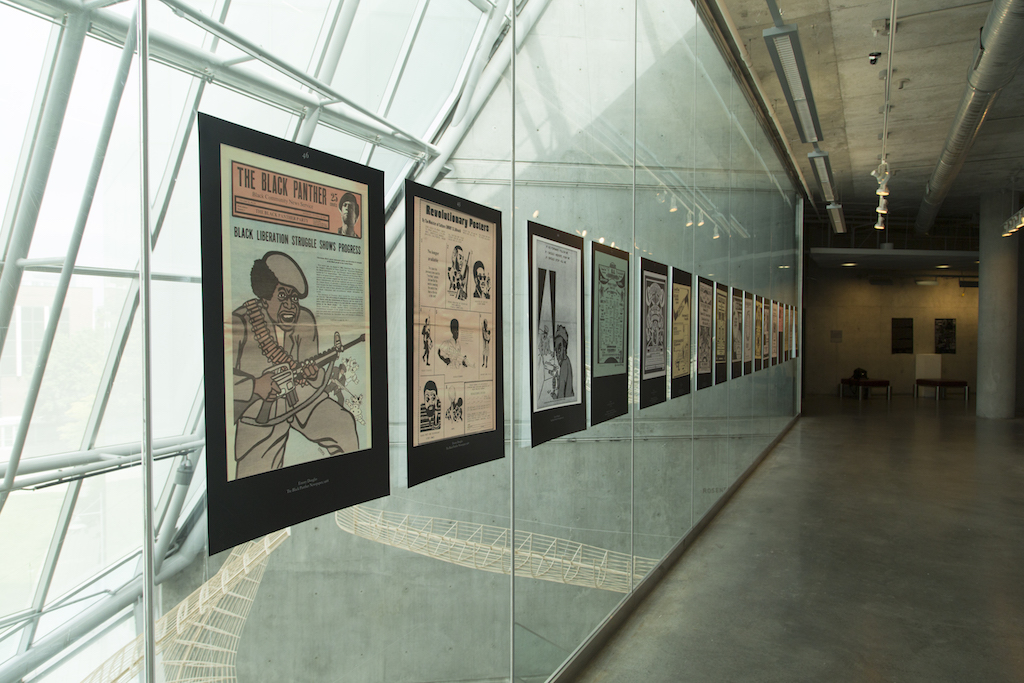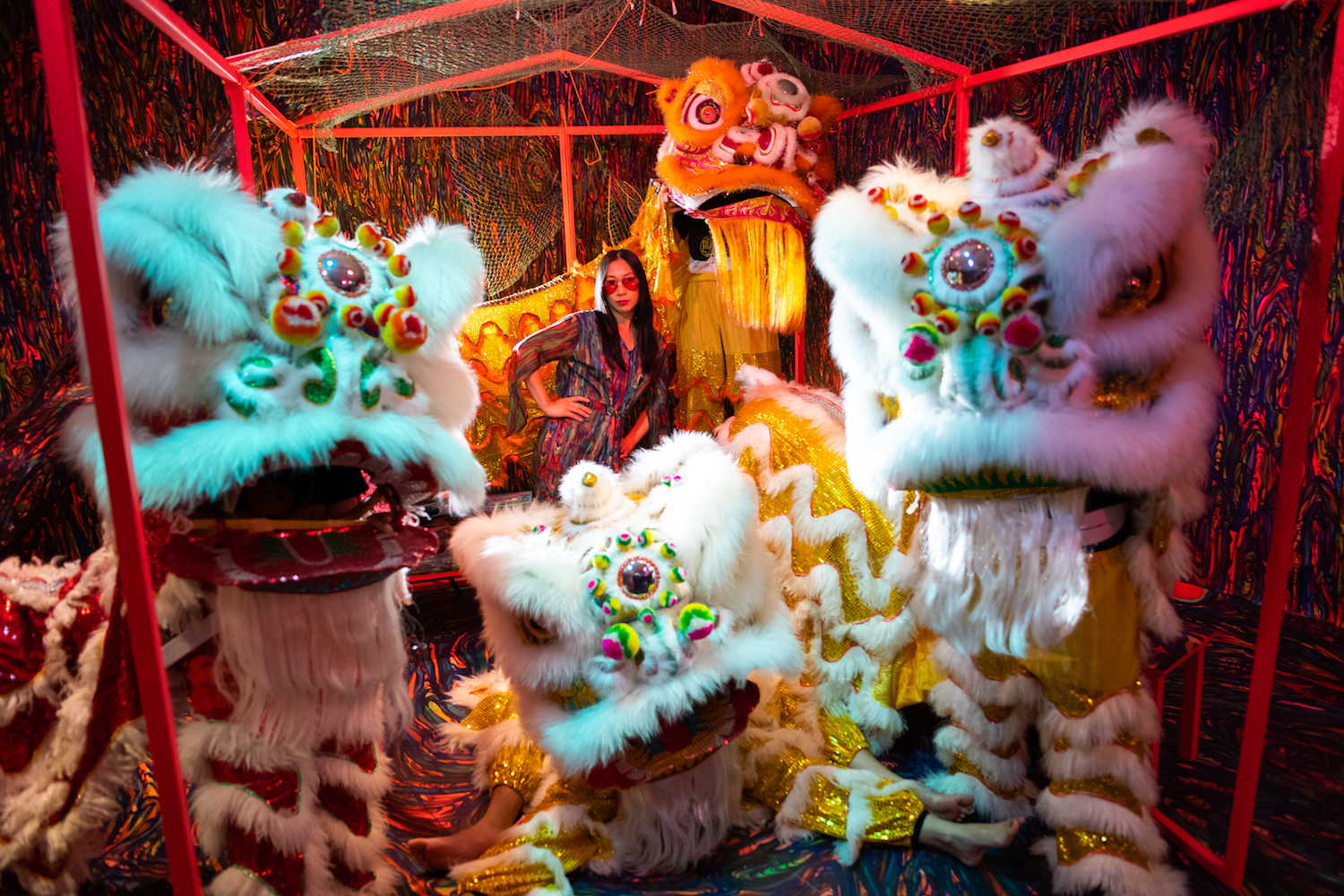An Interview with Phaan Howng on the Grand Finale of her Bombastic, Over the Top, Interactive Installation at the Baltimore Museum of Art by Cara Ober
When the Baltimore Museum of Art selected Phaan Howng for their third annual Commons Collaboration, they got their money’s worth. This ongoing project is a yearlong solo exhibit in the museum’s education wing where a Baltimore-based artist collaborates with a non-profit organization with a cause to create art and ongoing programming.
In the case of Howng, it was an opportunity to realize her beautifully terrifying, day-glo vision in The Succession of Nature, an immersive and shocking vision of a future earth where plants have aggressively taken over and humans are extinct. Acidic, twisting color, trippy plant-based patterns, post-apocalyptic structures, and arcane sounds were all a part of this project, and so were informational periodicals, workshops, and performances designed with Blue Water Baltimore, an environmental organization fighting pollution in our waterways.
What was particularly successful about the project is its insistence on a visual uniformity that envelops a visitor and creates a sense of nightmarish plausibility. Howng herself becomes a part of the installation when she wears a jumpsuit whose pattern matches the walls, and she employed a number of different collaborative teams–all wearing their own hazmat-inspired suits–and performers to engage with audience. The installation is photogenic and Instagram-friendly, but also quickly takes a visitor to a deeper place, inspiring concern and contemplation about the possibility of a very real impending environmental cataclysm facing our planet, providing takeaway information so that visitors who are inspired can take action against it.
Every artist thinks they want to have a museum show, but I am curious–from the artist’s perspective–what actually goes into it? What compromises does an artist have to be willing to make to realize their vision in a museum or other institutional / collaborative space? As Howng gets ready for the final performance of this project, called The End of Days Spectacular Spectacular on Sunday Sept 30, a collaboration with Goh’s Kung Fu and others, I reached out with a few questions about what she has learned over the course of a year.

Every artist thinks they need a museum show. What were your expectations, going into this project?
I guess my first expectations going into the project were more like an emotional experience, where I was like “AHHHHHHHH!!!!!” Like Home Alone style. To be honest, I didn’t really know what to expect. I just knew that I had a museum show and told myself, “Good job Phaan! Hopefully, your parents will respect what you’re doing now!” Either way, I wanted to kick ass and produce an awesome exhibition.
While working with the museum, it’s like being engaged with any other institutional bureaucracy, where you get crucial and amazing support from key departments that you are closely involved with and not so much support from other departments, or communication gets lost in other forms of communication… the usual.
Did you have expectations about working with a museum that turned out to be wrong? I am curious what you learned about museums, in particular, the BMA, and the way that they work with artists that you didn’t know before?
You get a lot of “no, you can’t do this” and “let me see if you can do that and we will get back to you…” and then there’s some “hey can you do this???” and then there’s “surprise! this happened in your space and we didn’t tell you because you can just find out on Instagram or when you get to the museum that it’s happening…” I don’t know what that’s called but I guess it’s the deal. It’s part of the learning process, but also I don’t care because I am just so happy to have the opportunity.
I don’t know if it’s just the BMA but consensus says that it’s the same across the board with every museum, based on talking to curators from other institutions and emerging or late emerging artists who have done this rodeo at other museums.
Can you talk about the way this project evolved over a year’s time? How did it change because of the collaboration and programming you did?
I originally envisioned the exhibition to be like my “ghost of Christmas future”– about what how the world would recover once humanity ended due to climate change or whatever human-based apocalypse would look like, and I really approached this from a global perspective. However the project evolved into being more Baltimore community focused because of the collaboration and programming.
I would get a lot of local groups that would reach out to me to speak about the show vs. say like Artforum being like, “Wow Phaan, tell us more…” Not sure what that means, but either way I am still happy to educate the immediate community about the effects of climate change and why we need to work harder to put more care into our local environment since it can affect not only us but also the global community. We are all tethered by the environment no matter what side of the globe we live on.

It’s safe to say that your visual work – painting and sculpture – grows in strength when there is a performative or interactive aspect to it. Do you see yourself as a visual artist, a performance artist, or both? Can you talk about the relationship between the images and objects you make and the acts and events they seem to require?
I think I switched myself from “painter” to just “visual artist” instead of something like “multi-disciplinary” artist–It feels a little pretentious? “Visual artist” can be even broader where you can encompass painting, sculpture, etc, and but also go performative and into any other medium you choose. Like, what if I direct the next Transformers movie? I don’t want to have to change titles nor really have one. It’s restricting.
Performance art and sculpture to me are friendzees and are very related. Performance, for me, like any theatrical production, you have to make it believable, but I want to also make it ridiculous where it becomes performative. It’s like this weird balance… kind of like stand up comedy? You have to have your set up and your punchlines to make the performance work. There is a lot of conceptual ideas that also have to help make the performance successful and that’s where sculpture and painting come in or vice versa. Either way, I find performance to be fun and interesting and a way to break free from being stuck in my painting brain.. and you’re right, the work grows in strength because of it.

We talked about collaboration in the BmoreArt journal #4 and you expressed a healthy skepticism about it. Who did you collaborate with for this project – can you name them all? It seems like a long list… and how did you work together? What is your opinion about the purpose and impact of collaboration on your work?
AHH HAHAHA. I’m still skeptical even though I am trying to teach my students about collaboration. I have a slide where I show a gif of a Shibu Inu helping his dad measure a piece of plywood by just holding the tape measure down as an example of how to collaborate. I also have a slide of how collaboration could be like Game of Thrones where John Snow has to rally all his enemies (even if they murdered his family or whatever) and people he doesn’t get along with to fight the White Walkers…. either way, nerdy pop culture examples of teaming together to fight for the greater good.
With Blue Water Baltimore, the non-profit I collaborated with, I felt like we both took turns being the Shibu Inu’s and John Snow. We helped hold the tape measure down while we still maintained our vision, our goals, our ideas and creativity, helped each other in terms of ideas and being consensual with each other on those ideas where it’s good for both parties, but also fighting for the greater good doing public outreach about protecting the environment and the importance of our waterways. Programming was the most “collaborative” in a way where we had a creative but business-esque meeting about what to do.
Michel Anderson, who I worked directly with from BWB happened to also have an arts background which really helped in maintaining autonomous creative visions for both of us in our public community programming. So I guess we would try to come up with ideas and at the end be like, “okay, how does this work for BWB and how does this still work for Phaan.com’s work, and how does this also benefit the BMA?”
In regards to The End of Days Spectacular Spectacular, I just pretty much told each group my vision, but allowed each group to also be creatively autonomous. I wanted them to have their own ideas instead of me dictating what to do. I just really wanted to provide the opportunity for these groups to shine and do their thing. IDK I guess that’s collaboration, Phaan style… which pretty much means outsourcing/delegating tasks to other groups.
What is collaborating, Cara? What is the real definition? I feel like “collaboration” is used a lot as the positive marketing word for, “We did our jobs.”

What has been the best part of this exhibit and project and what has been the most exhausting??
I AM SO TIRED.
The best part of having the exhibit is being introduced to groups beyond the art world and in either the local community or environmental community and to show like a gazillion cool people and my art idols such as Alice Aycock, Fabian Marcaccio, Tania Bruguera, and more the installation and being like, “Am I cool like you guys now? Can I join your club?” It has also been awesome to be like “yeah hieeeeeeee i have a show at the BMA, I’m like a real artist” to fancy people and other artists and curators who wouldn’t give you the time of day in the first place…
The exhausting part-time— My administrative work for myself compounded exponentially to invite people to see the show, deal with inquiries from groups about the show, honoring interviews, lectures, etc and other public engagements, while still applying for grants, residencies, and other glorious prizes, being in the studio to make new work for other shows, AND on top of that still having to work, teach, and work at the Mushroom Stand on Sunday’s at the Farmers Market to make money. #professionalpractices #artlife!!!
The other exhausting thing is when people and places ask if you can make an immersive installation like the BMA, and you’re like, “Well if you got the money honey, I got the time…” but in reality I don’t want to be known as making the same immersive installation in a different color palette like for the rest of my life. I have a soul and other ideas goddamnit!
Advice to artists who want to propose public projects to museums???
Know your shit. Do your research. Manage your expectations. And then do a dance where you pray for money to fall from the sky.

Following a welcome from Phaan Howng in The Succession of Nature exhibition, join Goh’s Kung Fu, Greenmount West Community Center drumline and colorguard, and Baltimore Dance Crews Project, for a parade to and performances on the BMA’s historic front steps, 4-4:45 p.m.
Enjoy refreshments from Mera Kitchen Collective, 5-7 p.m.
Take part in a hands-on painting activity, 5-7 p.m.
Hear youth DJs from Lillian S Jones Rec Center, mentored by DJ Trillnatured, 5-7 p.m.
In the event of inclement weather, parade and performances will be held indoors.
**Photos by Brandon Nehus






